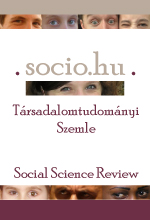The creation of resilient Roma cultural heritage
The creation of resilient Roma cultural heritage
Case study of a bottom-up initiative from North-Eastern Hungary
Author(s): Eszter György, Gábor OláhSubject(s): Ethnic Minorities Studies
Published by: MTA TK Szociológiai Intézet
Keywords: resilience; minority heritage; Roma heritage; community participation
Summary/Abstract: The notion of cultural heritage has become an essential part of social science discourse in recent decades, and its position and institutionalization vis-à-vis history-writing has been consolidated. Regarding minority culture and heritage, a central issue to consider is to what extent the previously marginalized minority heritage can stand on its own or emerges as part of the mainstream canon – due to increasing attention and acceptance. In the case of Roma heritage, one cannot ignore that the marginalization of Roma in Hungary is still palpable in numerous aspects and that their often very deprived social status also has an impact on the access to cultural heritage. Furthermore, this ongoing marginalization has a great impact on the access to power and control: as in academia and in political activism, the genuine presence of a “Romani voice” is still a goal to be achieved in heritage production as well. Therefore, in order to sensitively problematize and understand the present times’ cultural challenges (which may take the form of political activism as well), we are aiming to introduce the concept of resilient Roma cultural heritage in Hungary. In order to do so, the paper will test the applicability of this concept (of resilient cultural heritage) to a specific case study of the First Roma country House. Since the early 2000s, when resilience has become a central concept of cultural heritage discourses, cultural heritage is often manifested as a tool that gives a community the opportunity to create a reserve that increases its resilience and renewal capabilities. This model aims to link the theory of resilience with the preservation, use/re-use and management of cultural heritage. To create a bridge between the two concepts, participatory approaches seem to be the most suitable. By looking at the case study of the First Roma country House in Hodász,2 we would like to analyze the specific and unique position of a bottom-up cultural initiative that tackles the institutionalization of Roma traditions and heritage and creates real social cohesion on a local level, in a highly rural deprived area (Szabolcs-Szatmár-Bereg country). Our study (based both on field and desk research) on the Roma country House in Hodász, as an eminent example of resilient cultural heritage, represents the first stage of a large project, focused on the access to cultural heritage for wider participation in the preservation, (re)-use and management of European culture.
Journal: Socio.hu Társadalomtudományi Szemle
- Issue Year: 8/2018
- Issue No: Spec 6
- Page Range: 37-50
- Page Count: 14
- Language: English

